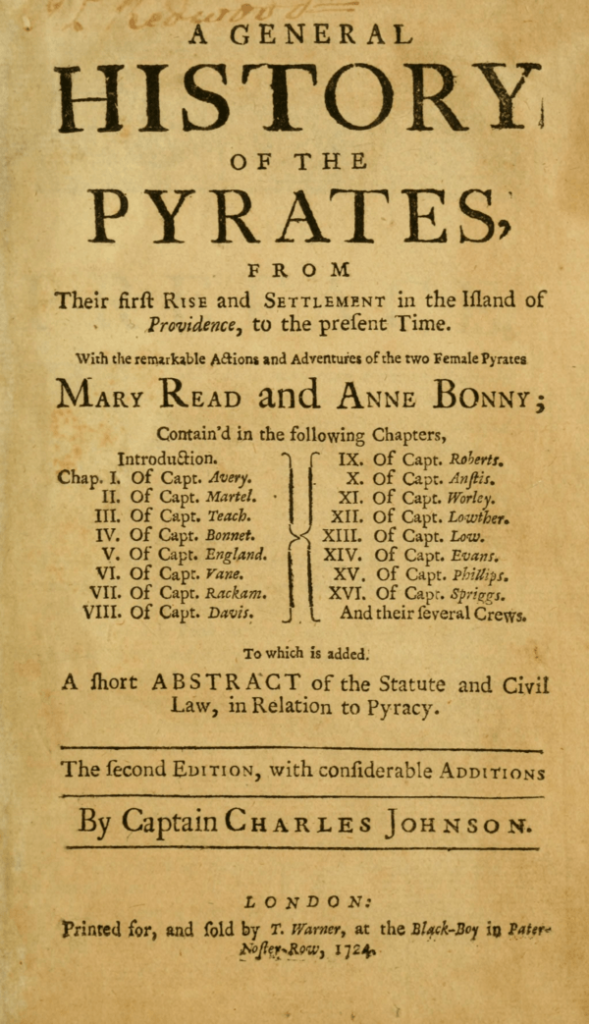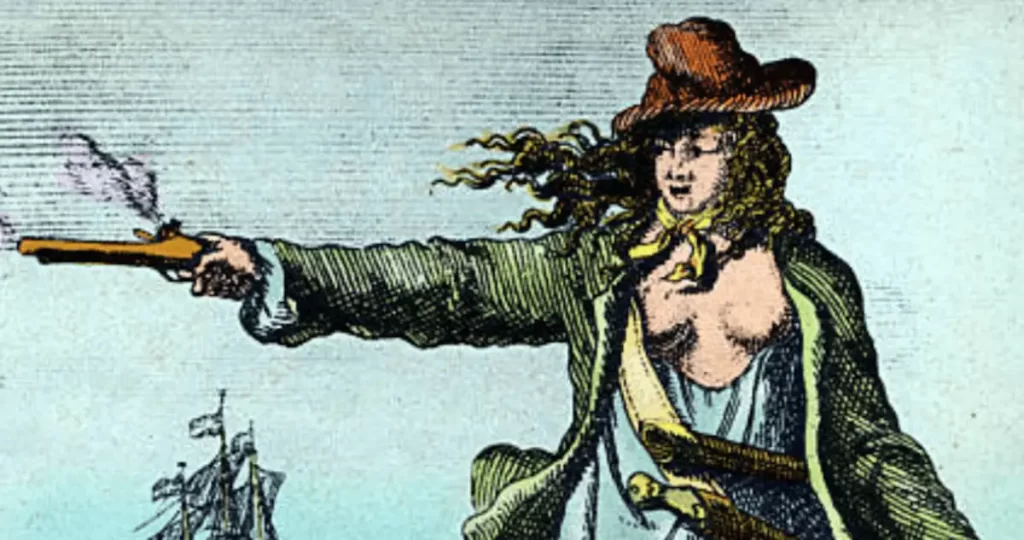Concealing her identity as a male, Anne Bonny emerged as a formidable buccaneer in the early 1700s, voyaging alongside Calico Jack and Mary Read in the West Indies. Traditional maritime norms disdained the notion of women as buccaneers. Indeed, the prevailing decree aboard numerous pirate vessels traversing the West Indies in the 18th century strictly prohibited the inclusion of any male children or females. However, Anne Bonny remained steadfastly defiant against such conventions.
Distinguished as one of the scant female buccaneers in history, Bonny garnered renown for her distinctive crimson tresses and emerald gaze, her swift, ferocious temperament, and her kinship with Mary Read, another female buccaneer who fortuitously found herself aboard Bonny’s vessel.

During a confrontation with assailants in 1720, Anne Bonny and Mary Read valiantly resisted while the majority of their male counterparts quivered in trepidation. Several were too inebriated to even wield their arms. This prompted Bonny to vociferate, “Cowards! Were there women in lieu of these feeble souls.”
This narrative recounts the saga of Anne Bonny — the resolute female buccaneer of the West Indies.
Anne Bonny’s Unorthodox Early Life Anne Bonny entered the world circa 1697 or 1698, in proximity to Cork, Ireland. From infancy, Bonny flouted societal norms. She was the offspring of William Cormac, a wedded solicitor, and his serving maid, Mary Brennan.
Cormac, fond of the child yet keen on preserving his matrimonial ties, attired Bonny as a boy and maintained her locks cropped short. He introduced Bonny as “Andy.” To outsiders, he asserted that the “lad” was merely apprenticing to become his clerk.
However, the truth eventually surfaced. Seeking refuge from the scandal, Cormac transported his mistress and daughter across the Atlantic Ocean. They resettled in present-day Charleston, South Carolina. While Cormac prospered — eventually amassing sufficient wealth to procure a plantation — Mary Brennan encountered misfortune. She succumbed to typhoid fever in 1711.

Following her mother’s demise, Anne Bonny’s “spirited and audacious demeanor” began to manifest. At one juncture, she purportedly plunged a kitchen knife into a chambermaid following a dispute — some accounts assert she extinguished her life. Bonny also thrashed a man who endeavored to assault her to the brink of mortality. Johnson recounts that Bonny’s assailant “remained indisposed for a considerable duration.”
Bonny commenced leading a libertine lifestyle, frequenting taverns by night and consorting with inebriates. Her father disapproved of her conduct, yet he maintained hope that she would secure a suitable spouse. However, Anne selected a destitute seafarer named James Bonny and wedded him in 1718. Johnson characterized James Bonny as an individual “affiliated with the maritime profession, devoid of any pecuniary value.”
Her father promptly disavowed her. Unfazed by his censure, Bonny departed for New Providence (now Nassau) in the Bahamas with her newlywed husband. Unbeknownst to them, they were venturing toward a region referred to at the time as the “Republic of Buccaneers.”

The Evolution Of A Formidable Buccaneer Anne Bonny swiftly grew disenchanted with matrimonial life. She and her spouse grew disillusioned with each other. He anticipated her arrival with her father’s wealth. Conversely, Bonny anticipated him to be a nonconformist, akin to her. Regrettably, James Bonny had devolved into an informer for a livelihood, aiding in the apprehension of buccaneers and earning a reward for his efforts.
Johnson described Bonny as “not entirely abstemious regarding chastity.” Ere long, her gaze wandered. It alighted upon a buccaneer captain named John “Calico Jack” Rackham. “She consented to desert [Bonny],” Johnson penned. “And embark on a voyage with Rackham disguised as a man.”
During that era, the presence of women among buccaneers was exceedingly anomalous. One notable exception was the 16th-century buccaneer Grace O’Malley, who, akin to Bonny, hailed from Ireland. However, most male buccaneers recoiled at the notion of admitting women aboard, deeming them harbingers of misfortune.

Rackham’s crew was not immune to this conviction. At one juncture, one of the buccaneers erred by articulating his disdain for Bonny’s inclusion on the vessel. Legend has it that she challenged him to a duel, impaled him through the heart, and cast his corpse overboard.
Henceforth, Anne Bonny was embraced as a member of the crew. Predominantly, assuming her role as Rackham’s paramour, she donned feminine attire. Nevertheless, Bonny assumed masculine garb whenever the vessel engaged in combat. She donned breeches and a tunic, armed with a cutlass at her waist and a flintlock in her grasp.
How Anne Bonny Encountered Mary Read The maritime realm harbors peculiar occurrences. Upon subjugating a vessel in the West Indies, Rackham adhered to the buccaneer code of conduct and extended an invitation to his vanquished adversaries to join his crew. Little did anyone know, Rackham was on the cusp of recruiting a second woman for his crew — Mary Read, masquerading as a man.
Anne Bonny found herself captivated by the novel crew member. Johnson recounted that Bonny “developed a particular fondness” for Read, whom she perceived as a “comely young Gentleman.” For motives “best known to herself,” Bonny divulged her true gender to Read. “To Anne Bonny’s profound Chagrin,” Johnson remarked, “[Read] divulged that she was a Woman as well.”
Bonny’s despondency purportedly endured fleetingly. Certain accounts insinuate that Anne Bonny and Mary Read forged an amorous bond during their voyage.

What emerges unequivocally is that, in Read, Bonny encountered a kindred spirit — and someone she could empathize with. Read, akin to Bonny, endured an atypical childhood. She too was branded an “illegitimate” offspring. Moreover, Read was attired as a boy and bestowed with a masculine appellation — “Mark.”
However, most significantly, Read was equally intrepid. In one anecdote, Johnson narrates how Read — then enamored with a mild-mannered, male crew member — engaged in a duel to safeguard her paramour from harm.
As Bonny and Read grew closer, Rackham’s resentment burgeoned. He perceived Mary Read as a male — a rival. “Consumed by jealousy,” Rackham menaced to slit Read’s throat. “Hence,” Johnson chronicled, “to placate him, [Bonny] divulged the secret to him as well.”
Plausibly, Rackham became privy to “the Secret” in more ways than one. Certain accounts intimate that Read, Bonny, and Rackham formed a buccaneer ménage à trois.
Her Apprehension On The High Seas Throughout the autumn of 1720, Rackham and his crew looted seven fishing vessels and two sloops — seizing captives and plunder.

Predictably, authorities took notice. On September 5, 1720, a proclamation in the Boston Gazette denounced Rackham and his crew as “Buccaneers and Adversaries of the Sovereign of Great Britain.”
Anne Bonny and Mary Read had garnered infamy as well. Following their raid on a sloop, its captain recollected them thus: “dissolute, cursing and swearing copiously, and exceedingly eager and willing to partake in any activity aboard.”
A former captive of Rackham’s crew recounted how Bonny and Read “brandished a cutlass and pistol, and uttered profanities at the men.” The proclamation of September 5th likewise singled out “two Women, by appellation Ann Fulford alias Bonny, & Mary Read” as buccaneers.
In October 1720, the long arm of the law ensnared Rackham, Bonny, and Read.
That fateful night, as the crew revelled in their streak of good fortune, Bonny and Read discerned a sloop swiftly approaching. They sounded the alarm. However, the crew was too inebriated to ready themselves for battle. Some had succumbed to inebriation, while others sought sanctuary below decks. As the sloop initiated its assault, Bonny and Read stood among the scant sailors who retaliated.
“If there’s a man among ye, ye’ll come up and fight like the man ye are to be!” Read exhorted as the vessel succumbed to the onslaught. When no aid arrived, she discharged a shot below deck — felling one of her crewmates.
Yet their efforts were futile. Read, Bonny, Rackham, and their cohorts were apprehended and conveyed to Jamaica to stand trial. The buccaneers were promptly sentenced to death.

Confronting the gallows, Rackham lodged one final entreaty. He yearned to see Anne Bonny before his demise. Bonny acquiesced to meet her former paramour and captain — albeit she proffered no words of solace. Confronting Rackham in his cell, she informed him that “she regretted to witness his predicament, yet had he fought valiantly, he need not have met his end in such ignominy.”
Both Anne Bonny and Mary Read evaded the hangman’s noose by professing pregnancy. Upon verification, their assertions were corroborated. They were relegated to adjacent cells to await the delivery of their offspring.
Mary Read expired in confinement on April 28, 1721. Nonetheless, Anne Bonny’s fate remains enigmatic.
It is plausible that she perished in prison, akin to Read. However, alternate accounts intimate that her father’s esteemed reputation facilitated her release from incarceration. These narratives suggest that she returned to South Carolina, remarried, and bore several offspring.
“As for her subsequent fate,” Johnson penned. “We are in the dark; all we know is that she was not executed.”
Anne Bonny’s Enduring Impact While contemporaneous accounts of Anne Bonny’s exploits were chronicled, certain historians posit that these chronicles were subsequently suppressed — likely to deter other women from entertaining audacious aspirations.
“[Bonny and Read] defied gender norms and astounded society at the time,” observed Professor Kate Williams. “They were pioneers in an exceedingly male-dominated milieu who carved their own path… [yet] they have been consigned to obscurity in historical annals.”
Anne Bonny’s saga may have been relegated to obscurity in the 18th and 19th centuries, but it appears to have experienced a resurgence in the 20th and 21st. Nevertheless, historical treatises seldom contain extensive depictions of Bonny.
Nonetheless, she has been featured in cinematic productions such as Anne of Indies (1951) and Through the Eyes of Men (2013). Bonny has also been immortalized in video games (Assassin’s Creed IV: Black Flag) and on television (Black Sails). Moreover, she has made appearances in musical compositions, novels, and manga.
In November 2020, Anne Bonny’s companionship with Mary Read was enshrined in a statue depicting the two women standing in unity on Burgh Island in the United Kingdom. Henceforth, they can survey the waters where they encountered love, renown, and adventure centuries ago.



